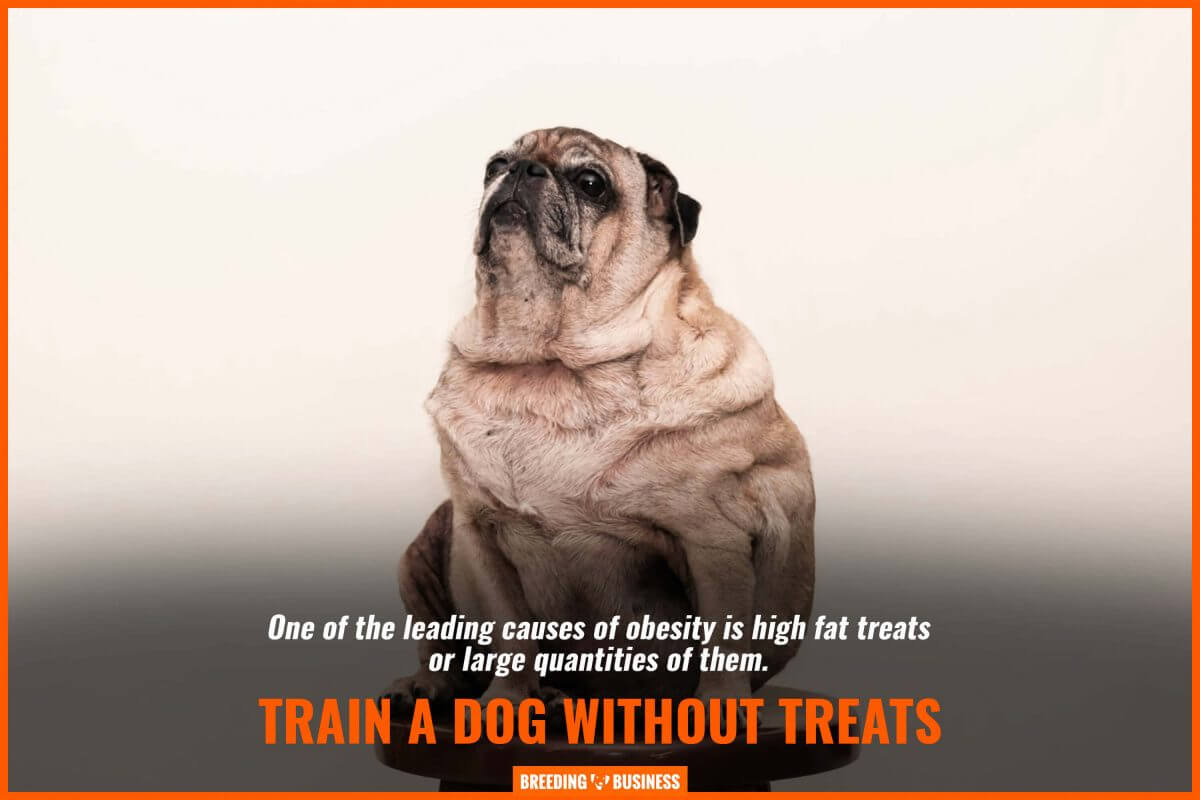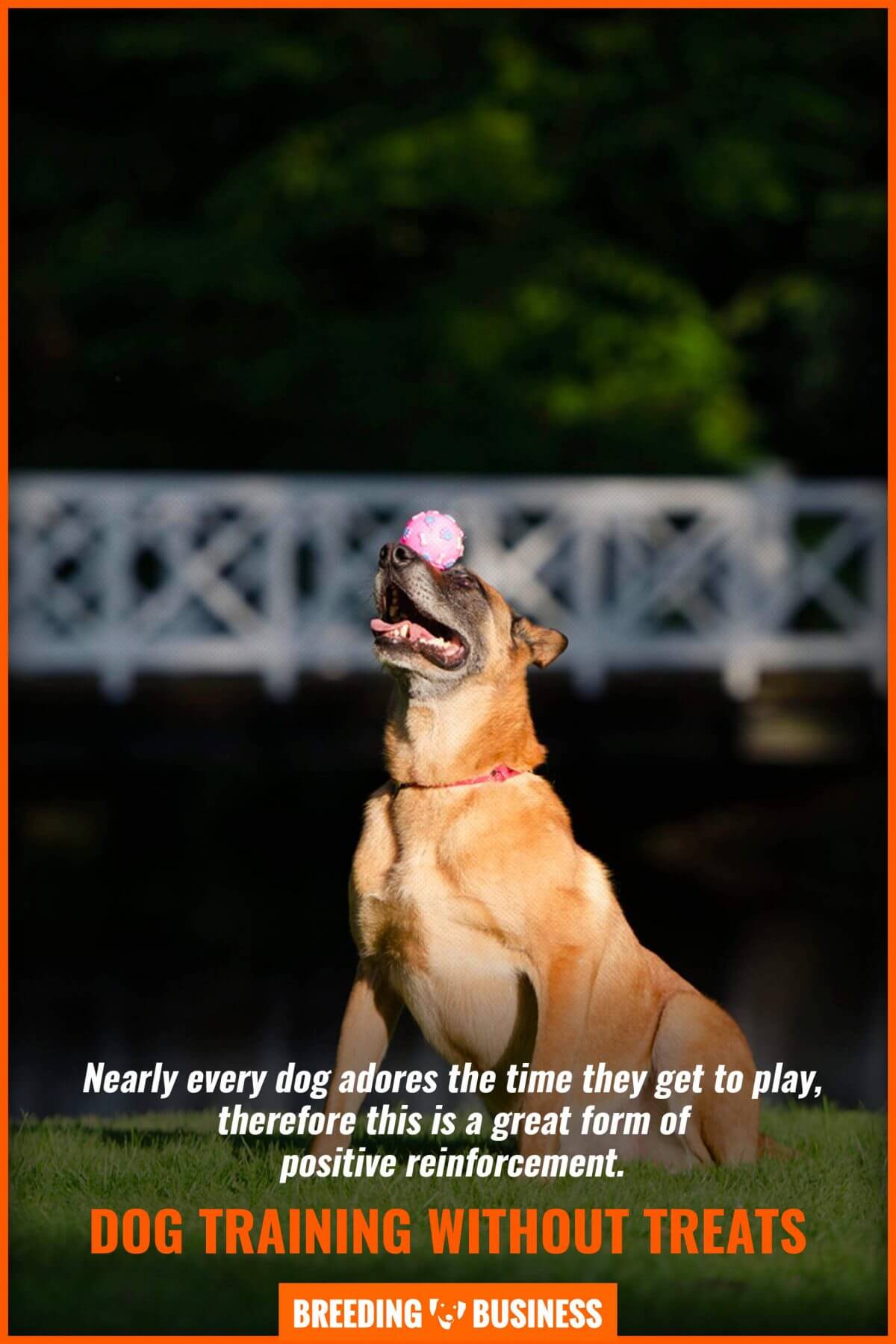If you are considering how to train your dog, most owners immediately think about using treats to do so. Whether it be through positive reinforcement or negative association, treats can be used in many training methods. Therefore, you may wonder how to perform dog training without treats.
Training with treats can lead to negative consequences such as obesity and even behavioral problems. You may want to preemptively prevent these behaviors or stop them from worsening. We will explain the best methods of training dogs without treats and what benefits these may bring.
Why You Shouldn’t Treat Your Dog While Training
Although using treats in dog training is common, there are some negative consequences including obesity and attitude problems.
Obesity
One of the leading causes of obesity is high fat treats or large quantities of them. When you are training your dog, rewarding them dog with treats may be frequent. This is so your dog can begin to be reinforced for a certain behavior with treats. Therefore, they will seek out to behave this way to gain more of this positive reinforcement.
So why do treats cause weight gain? This is because dog treats are high in fat, sugar, and carbohydrates for a more palatable taste. The better tasting a food is, the more a dog craves it. Hence why treats are often much more unhealthy than regular dog food. If you are training a dog, the more a dog enjoys their treats, the more likely they are to strive to gain more. Dog training can lead to a rise in unhealthy food provisions such as dog treats. These come under food groups that dogs require minimal amounts of and are stored as excess fat leading to obesity.

Attitude Problems
The more treats you give your dog, the more they may expect to receive them. This can occur in certain breeds with higher levels of confidence or more difficulty with training. They may initially begin begging by your feet for more treats when rewarded in training. This can quickly progress to your dog sniffing to find where the treats are stored and then begging in this area. Their begging may include whining, barking, howling, pawing, and digging. This can be frustrating to have to deal with, especially if it develops into a regular occurrence.
Although this behavior can occur from improper training, such as excess treat rewarding or improper timing, some dogs may develop this just because of being rewarded with treats. Therefore, you have to be prepared that any treat training can result in this response and you may want to look for alternative training methods such as training dogs without treats.
Methods of Dog Training Without Treats
There are multiple methods you can consider if you wish to train your dogs without using treats. These can be through association or reinforcement and can be just as effective with patience.
Using Hand Gestures
There is a form of dog training where you can train your dog to associate different hand signals for different behaviors. How can these signals be used alone to encourage behavior though? As they are not a direct form of positive or negative reinforcement or association? Well, with the repeated visual display of a hand signal for a certain desired behavior, your dog will slowly begin to associate one another.
There are some considerations you must put into place though. This technique requires a lot of patience as there is no direct enforcement of it, for example, praise. Furthermore, with very hyperactive dogs or those with high levels of aggression or anxiety, this technique is not the best. Hand gestures are effective where a bond is already formed between a dog and their owner and they are already calm and relatively obedient.
Verbal Encouragement
Verbal encouragement and play can have a huge influence on our dogs’ behavior. Praising them with positive phrases such as ‘good boy’ or ‘clever girl’ can make them feel good and happy about a displayed behavior. Therefore, you should attempt to praise your pup after they have performed something you would like to see more of. For example, when they do not bark at the postman, let them know you appreciate it.
It has been discovered that a change in your tone can influence your dog’s behavioral response as well as their perception of you. A higher pitch with a positive tone can increase your dog’s mood as well as leading to a positive association with good behavior. So if the benefits of training your dog without treats isn’t enough, consider that talking to your dog like this makes them happier and strengthens your friendship.
Playing
Nearly every dog adores the time they get to play, therefore this is a great form of positive reinforcement. When your dog performs good behavior such as urinating outside and not inside, you can then initiate a form of play. Preferred behavior should always be followed up with play such as throwing a ball or using a tug rope.
Difficulties can ensue when play is used generally, as it may accidentally reinforce negative behavior. For example, your pup chewing may be reinforced through play and they may, therefore, begin to chew on furniture. Or your puppy may have urinated without you witnessing it happening, then play may reinforce that this behavior is okay. This is because play is enjoyable and fun for your dog, therefore they will aim to perform a behavior to get to play again. Be sure not to take away toys for bad behavior, just encourage good behavior with play.

Life Rewards
A life reward can be defined as something your dog wants, this can be in a moment or generally. For example, your dog may crave attention if they are a particularly human dependent breed or individual. Other dogs that have high energy levels may feel rewarded by engaging in a session of play or being taken for a long walk. The use of rewarding a dog’s positive behavior with life rewards is a treat-free response to encourage these behaviors to reoccur.
It can often be difficult to know how to use a life reward in training. The best way to use this technique is to give an immediate positive response after a preferable behavior. For example, your dog has stopped barking? Grab their favorite toy for a play session. Another example is as soon as your dog urinates outside, grab their lead and tell them “walkies”. This immediate excitement is what causes your dog to try to replicate this behavior.
Physical Encouragement
Everyone knows dogs love affection. Some may adore gentle stroking and snuggles, whereas others may enjoy play fighting. Regardless, physical encouragement can be used as an effective training tool with the correct timing. Firstly, you need to find out what kind of physical affection your dog would enjoy the most. Does your pup prefer cuddles, tummy rubs, play, or even just scratching their side? Learn more about what your dog enjoys the most and use this method to reward your pup.
You can implement this training method by praising your dog with physical attention after a preferred behavior has been displayed. For example, if your dog sits when you tell them to, give them a good cuddle, they deserve it. By rewarding your pup with physical attention, they will strive to gain more and perform the same behavior again. This technique is especially beneficial for dogs that are more human dependent.

5 Best Books About Dog Training Without Treats
None of the books on our top five list use dog training without treats as their primary focus. However, all of these books give the best tricks and techniques for how to train dogs without treats.
1. The Art of Raising a Puppy
The Monks of New Skete are a monastery that specializes in dog obedience and training. They often follow and take inspiration from AKC training methods and shows. Although they typically work with German Shepherds, they are able to recommend training techniques for all dog breeds.
This book is a bestseller in behavior and training due to the Monks of New Skete’s reputation. They are widely renowned for adjusting a badly behaved dog into an obedient friend. The most recent addition of the book has chapters dedicated to playing and its influence on our dog’s behavior. Furthermore, this addition has up to date information on canine health to make sure that the training methods consider your pup in all aspects, for example, treat-induced obesity. This book has a useful section discussing puppies’ developmental stages and what form of training is received the best in different life stages.
2. 101 Dog Tricks
Kyra Sundance‘s obedience training book titled 101 Dog Tricks is a worldwide bestseller. Over half a million copies have been sold worldwide due to their clear step by step instructions and illustrations. This book has been praised for its clear depiction of different training techniques for tricks and behavior. Below are the book’s praised top ten training tips:
- Reward with tasty treats
- Always reward while your dog is in the correct position
- Reward immediately (no fishing in pockets)
- Train before dinner
- Training comes before playtime
- End the session with your dog wanting more
- Be consistent
- Motivate—use your happy voice
- Be patient—it won’t happen overnight
- Be a fun person to be around
Whether you are interested in training your dog without treats or with, these tips introduce a writer who knows dog behavior in all circumstances of training.
3. Dog Training Revolution
Zak George and Dina Roth Port collaborated to write “Dog Training Revolution: The Complete Guide to Raising the Perfect Pet with Love“. This book has been praised by behaviorists and veterinarians alike on it’s humane training techniques. Each chapter targets different training methods and factors to consider, which means you can read it linearly or look at the chapter you are interested in.
Zak George considers many different training methods throughout his book so it can help to aid owners interested in many kinds of training. This includes dog training without treats.
4. How to Raise the Perfect Dog
The best selling author Cesar Milan has written “How to Raise the Perfect Dog“. The book includes considerations towards your puppy’s development alongside training. This means there are different training techniques suggested for each developmental stage. This book tells you how to prevent behavior problems continuing, but also how to prevent them from occurring. Here is a general outline of the book according to Amazon:
- What to expect from each stage of your puppy’s development
- Quick and easy housebreaking
- The essentials of proper nutrition
- The importance of vaccinating–and of not over-vaccinating
- Creating perfect obedience from day one through rules, boundaries, and calm-assertive leadership
- How to avoid the most common mistakes owners make raising puppies and young dogs
- How to correct an issue before it becomes a problem
- Unique exercises and play to bring out the best in every breed
5. The Big Book of Tricks
Larry Kay wrote “The Big Book Of Tricks For The Best Dog Ever”. This book uses advice from professional behaviorists and trainers to explain the training behind “118 tricks and stunts“. Not only does this book discuss the different training methods you can consider, but it also mentions the many health and relationship benefits that come from training. For example, your dog can develop a greater bond with you during training, feel less anxious, and their energy can be used up during training.
Dog training without treats is not only possible, but highly effective. It has health benefits for your dog and can be a good training method whilst minimizing costs and obesity.





